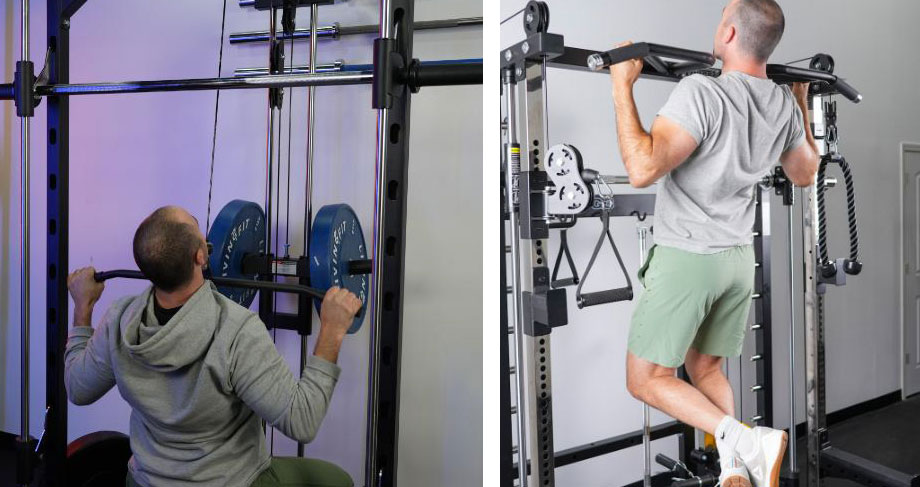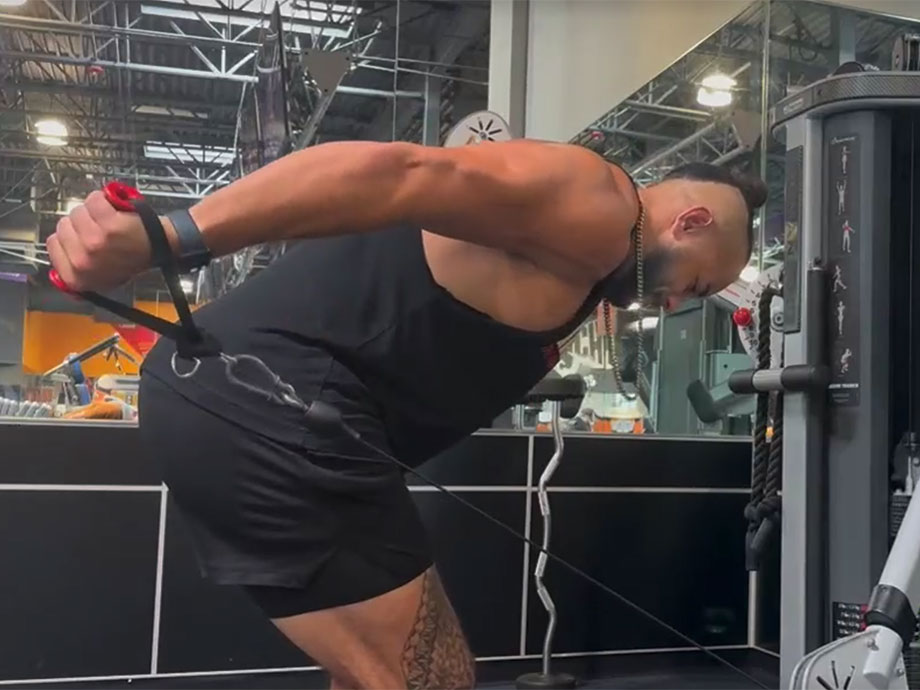You’re probably well aware that two of the best back exercises are the lat pulldown and pull-up for muscle activation in your lats, biceps, and upper-back muscles. It’s rare to see a back workout without one or the other (or, in some cases, both!).
RELATED: Exercises for Upper Back
But you might be wondering about the similarities and differences between the two movements. Should you choose over the other for your back day training? Or is it better to perform both to maximize muscle growth?
Read on, and I’ll answer your questions based on my experience as a certified personal trainer (CPT). I’ll also give you a step-by-step breakdown of how to do both exercises with proper form.
Quick Look: Lat Pulldown vs Pull-Up
Lat pulldowns and pull-ups are popular upper-body exercises that build strength and size in your lats, biceps, and various muscles in your back. They’re compound movements, and both exercises have a variety of grip widths and hand positions you can try.
RELATED: What Muscles Do Pull-ups Work?
However, there are differences. Pull-ups are a calisthenic exercise and require you to lift your entire body, whereas lat pulldowns use a resistance machine. This makes pull-ups a more challenging back exercise when compared to lat pulldowns.
Key Similarities Between Lat Pulldowns and Pull-Ups
Let’s get to the similarities between lat pulldowns and pull-ups:
They Activate the Same Muscles
The primary mover for both exercises is the latissimus dorsi (aka the lats). However, lat pulldowns and pull-ups also hit the biceps, core, and other muscles in your upper back, including the rhomboids, traps, teres major and minor, and more. Therefore, both bodybuilding exercises are nearly interchangeable because they activate the same muscle groups.
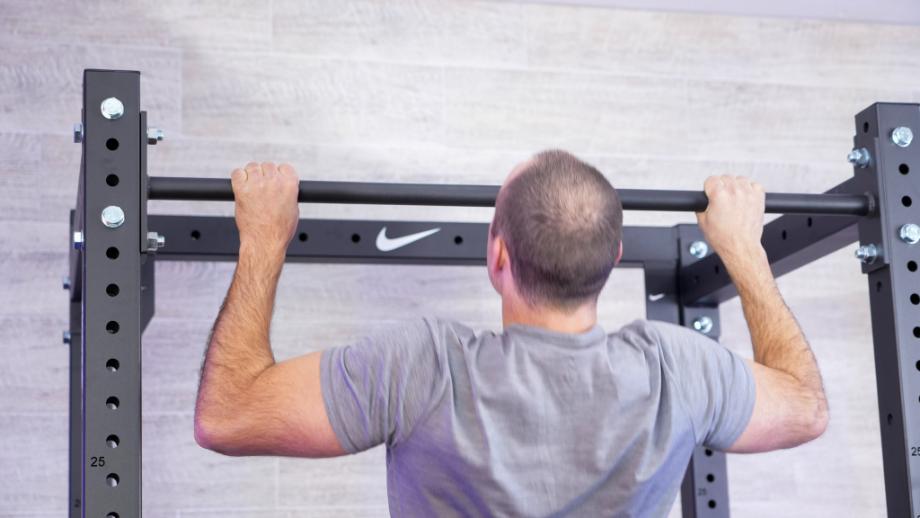
They’re Both Compound Exercises
Compound exercises—such as the lat pulldown and the pull-up—train multiple muscle groups. If you want to build muscle in less time, you’ll want to add compound movements into your workout routine rather than isolation exercises, which only hit one muscle group at a time.
You Can Vary Grip Positions
You can have a wide grip, neutral or shoulder-width grip, or close grip. You can even switch to an underhand grip if you like—though technically, this is a chin-up and not a pull-up. With both exercises, you can play around with various grip widths and hand positions to hit the biceps and upper back muscles in slightly different ways.
Important Differences Between Lat Pulldowns and Pull-Ups
Now that you know the similarities, it’s time to explore the differences. Here are what I deem the three most important:
Fixed Machine vs Body Weight
With the lat pulldown exercise, you adjust the weight stack on a fixed resistance machine and perform the vertical pulling motion by bringing the bar to your upper chest. Pull-ups are a bodyweight exercise that requires you to lift yourself against gravity to reach the bar. Therefore, even though both exercises work the same muscles, the movement pattern is completely different.
RELATED: Bodyweight Back Exercises
Different Levels of Difficulty
Lat pulldowns can be performed by beginners and those who have been strength training for some time. Even if it’s your first time in the gym, you can choose a lighter weight and perform the pulling movement. Pull-ups are more difficult because they require solid grip strength and the ability to lift your own body weight. They usually come easier to people who have more experience in the gym.
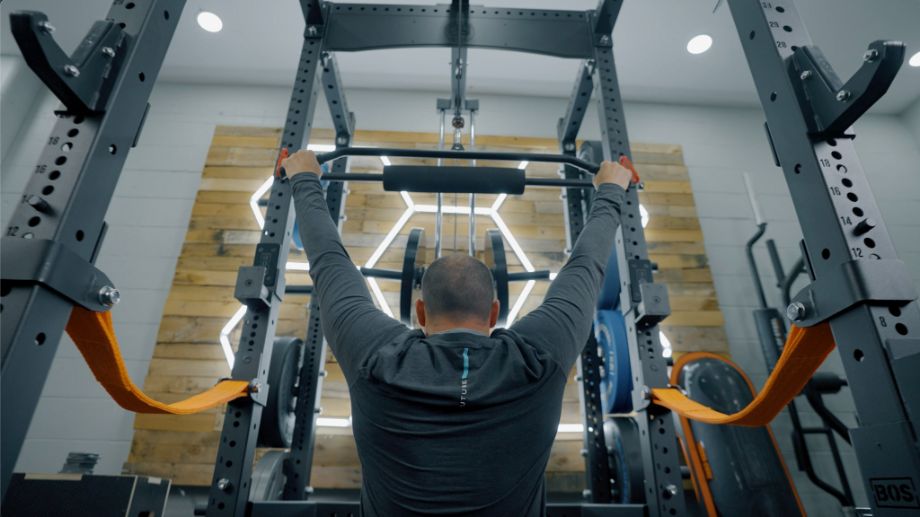
Number of Sets and Reps
Because of the differing difficulty levels, the number of reps per set is different for lat pulldowns vs pull-ups. For lat pulldowns, I advise clients to aim for between eight and 12 reps for muscular hypertrophy. On pull-ups, it’s between three and eight reps for strength. You can easily do four or five (or more!) sets of lat pulldowns, but two or three sets of pull-ups are plenty.
How to Perform Lat Pulldowns
Why do it: They’re great for beginners and more advanced gym-goers because they use a fixed cable machine that can easily be adjusted for any requirements. Another benefit of using a lat pulldown machine is that it provides constant tension throughout your full range of motion.
How to do it:
- Choose your desired weight and attachment. (The most commonly used attachment is the straight bar, but you can also use a short bar or a V-bar.)
- Grab the attachment with either an overhand, underhand, or neutral grip. Sit down with your knees underneath the pad and retract your shoulder blades.
- Slightly lean back and pull the attachment toward your upper chest.
- Pause before slowly returning the attachment to the starting position.
- Reset and repeat for reps.
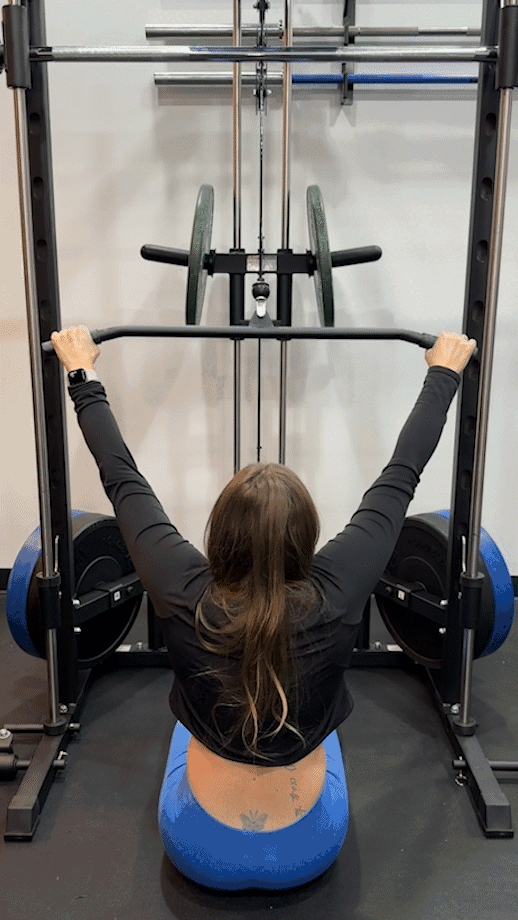
Benefits of Lat Pulldowns
- You can adjust hand positions to work the muscles differently1. A wide grip is best for the lats, but for the rear delts, you might want to switch to a supinated or close grip.
- Lat pulldowns are safer than pull-ups because the form is easier to master. This makes them an excellent exercise for those new to weight training.
- Increasing or decreasing the load takes a couple of seconds, making them effective for drop set workouts.
- Doing them regularly can help you become stronger at other back exercises, including one-arm dumbbell rows, barbell rows, and of course, pull-ups.
How to Perform Pull-Ups
Why do it: Pull-ups are a serious test of your upper-body strength and can give you added confidence in the gym when you’re able to do them for reps (trust me, I know the feeling!). Although commonly done with a wide grip, you can alter grip widths to hit your muscles differently.
How to do it:
- Position yourself under a pull-up bar. Take hold with an overhand grip (palms facing away from you), usually with a wider hand position (but it can be narrower if preferred).
- Lift your feet off the floor to get into the dead hang position.
- Brace your core, stick your chest up, and use your back muscles (not your arms!) to pull yourself up toward the bar.
- Once your chin clears the bar, hold for a moment, then return to the original position in a controlled manner.
- Keep going for repetitions.
RELATED: How To Do a Pull-Up
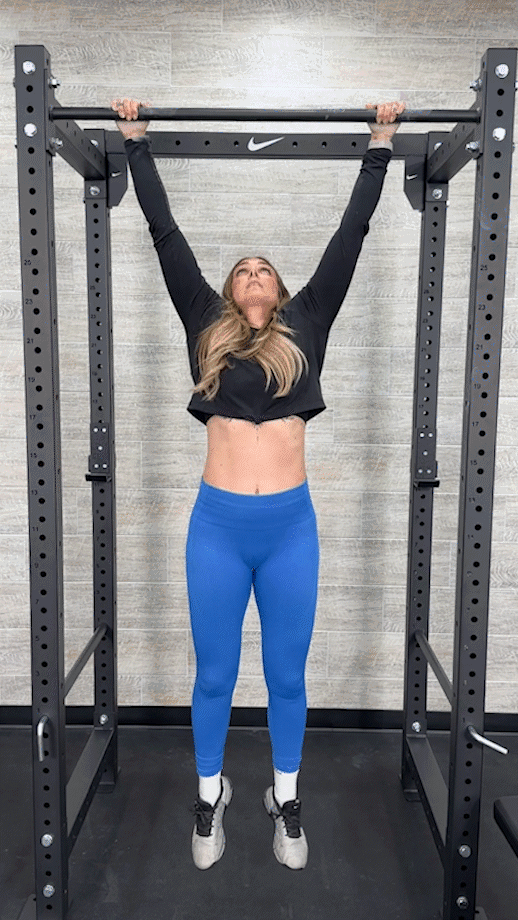
Benefits of Pull-Ups
- Pull-ups can be done from practically anywhere because all you really need is a pull-up bar. Most gyms have these or you can buy one for home relatively inexpensively.
- You can use a resistance band to help make your pull-ups easier or do weighted pull-ups to make them more challenging—check out our article on pull-up progressions for more.
- Pull-ups hit your core to a greater extent than lat pulldowns. This is because you use your core to stabilize yourself when in the dead hang position and to lift your body weight.
- You’ll improve your grip strength, which can help with deadlifts, bench presses, overhead presses, and other compound lifts.
Lat Pulldown vs Pull-Up: Which Should You Do?
Okay, let’s get down to it. You know how to do both the lat pulldown and the pull-up with proper form, but which one should you choose? See below for a few factors that could affect your decision:
How Long You’ve Been Training
If you’re a beginner, start with the lat pulldown. Even if you think you could do a few reps of pull-ups, I’d still recommend doing lat pulldowns for a short while. The technique is easier to learn, and the risk of getting injured is lower. If and when you eventually switch to pull-ups, they’ll feel smoother because you’ve already built muscle in your upper back.
RELATED: Cable Back Workout
Your Fitness Goals
Above, I mentioned that the number of sets and reps is one of the differences between lat pulldowns and pull-ups. If your goal is muscular hypertrophy, then unless you can do out three to five sets of 10 reps on pull-ups—no, neither can I—stick with lat pulldowns. If muscle growth isn’t your goal but strength is, try pull-ups and do fewer reps and sets.
The Equipment You Have Available
Weightlifters training in a commercial gym are likely able to do both exercises. However, for those training at home, you may not have access to a lat pulldown machine (Check out our DIY Lat Pulldown article to craft your own). But you can pick up one of the best pull-up bars and start on pull-ups immediately, or loop a band around your pull-up bar and train pulldowns that way. The resistance band can help you train those muscles until you can access a lat pulldown machine and progress your load.
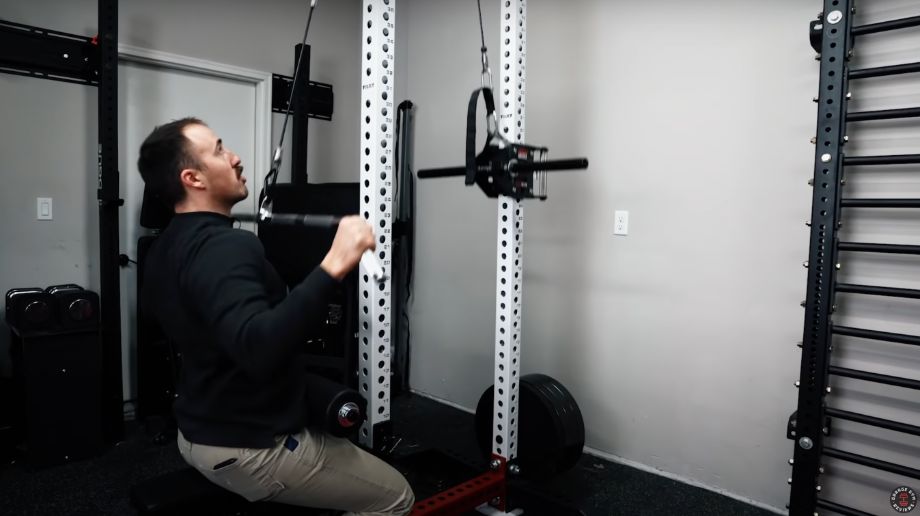
Your Enjoyment Level
Choosing lat pulldown vs pull-up also comes down to your enjoyment levels. I can explain all the benefits of pull-ups, but if you don’t enjoy them, you won’t do them. I believe it makes sense to recommend exercises that people enjoy because they’ll have higher levels of training adherence.
But if your question is: “Do you need to pick?” I don’t believe so. Lat pulldowns and pull-ups are two of the most popular back exercises for a reason—they both work. I do both exercises with clients. Either we do lat pulldowns on one day and pull-ups on another, or we do both in the same session. Unless there’s a reason preventing one over the other, I believe the answer to “Which exercise should you do?“ is both.
Lat Pulldown vs Pull-Up: Final Thoughts
When it comes to lat pulldowns vs pull-ups, the jury is out. Both exercises have similarities (compound movements, activate the same muscle groups, and offer several grip positions) and differences, including the difficulty level and the number of repetitions and sets you can perform.
Equipment, preference, fitness level, and training goals also may affect your decision, but I suggest including both exercises in your workout routine.
Lat Pulldown vs Pull-Up: FAQs
Are pull-ups better than lat pulldowns?
The short answer is no. As a certified personal trainer (CPT), I wouldn’t say pull-ups are better than lat pulldowns—they’re just different. Both are compound movements and work the same muscle groups. However, pull-ups are a bodyweight exercise and more difficult. Therefore, most people can do fewer reps and sets on pull-ups compared to lat pulldowns. With that said, I would include both exercises in any workout program when possible.
Can I replace lat pulldowns with pull-ups?
If you’re not enjoying lat pulldowns or don’t have access to a lat pulldown machine, then yes, you can replace lat pulldowns with pull-ups. Both exercises target the same muscle groups.
However, before you do, consider your fitness goals and training age. If you’re a beginner, I wouldn’t replace lat pulldowns with pull-ups because lat pulldowns are safer and more manageable. If you’re used to doing eight to 12 reps on lat pulldowns for hypertrophy, and you can’t match this with pull-ups, you might want to wait before fully replacing lat pulldowns with pull-ups.
Are pull-ups good for lats?
Yes, pull-ups are great for the lats, biceps, core, and other muscles in your upper back, including the rhomboids, traps, and teres major and minor. Although there are several great exercises for the lats (for example, lat pulldowns, one-arm dumbbell rows, barbell rows, and more), pull-ups are one of my favorites.
References
- Signorile JF, Zink AJ, Szwed SP. A comparative electromyographical investigation of muscle utilization patterns using various hand positions during the lat pull-down. J Strength Cond Res. 2002 Nov;16(4):539-46. PMID: 12423182.


